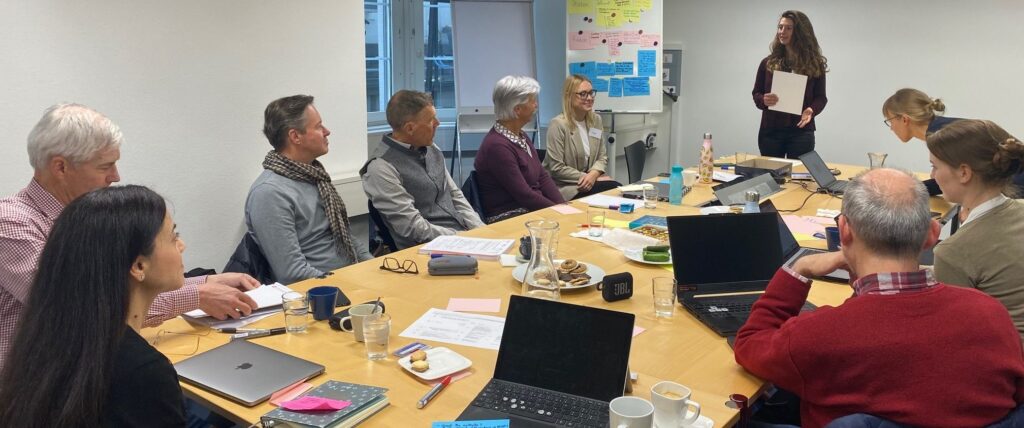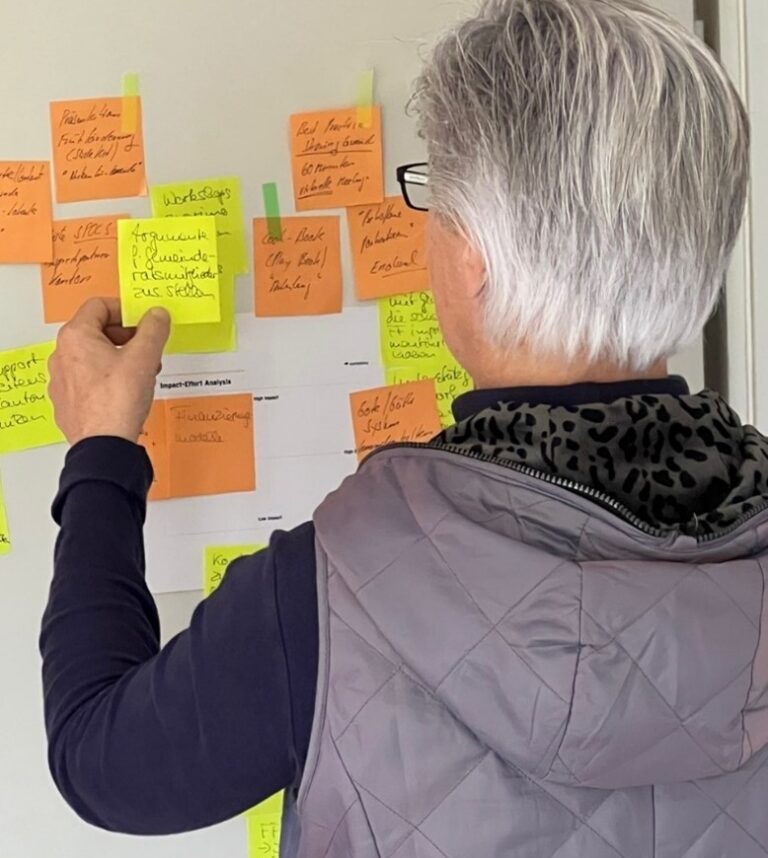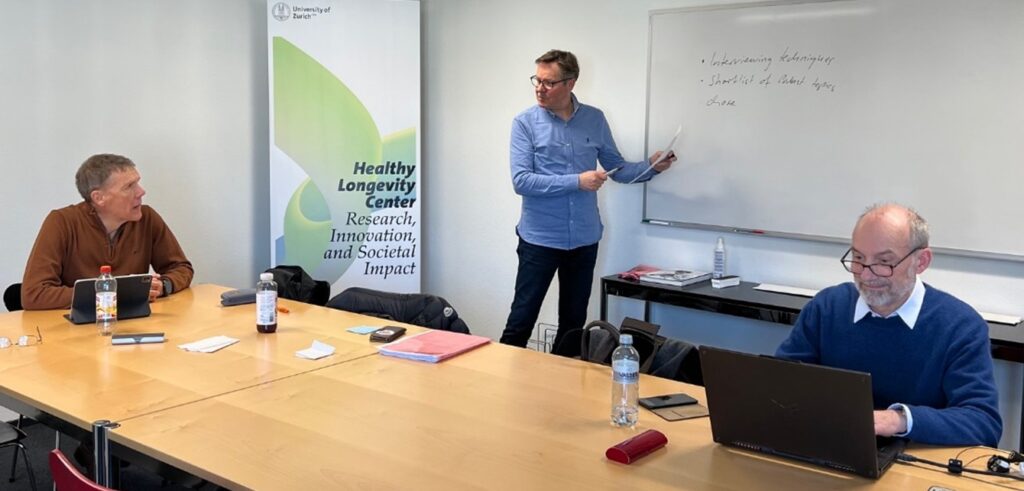Design Thinking for Learners 60+
Design Thinking is a widely used way of thinking that aims to solve problems. We have offered an e-learning course to learners 60+. Read here about Design Thinking, its potential, and what we know so far about its benefits for learners 60+.
Our Idea
Learners 60+ can also benefit from applying Design Thinking in their everyday lives. Not only as a target group for younger product developers but also independently in their role as developers, planners, and implementers.
That’s why we offered a Design Thinking course for older learners to test it and find out whether the participants can really benefit. Over the course of three months, learners aged 60+ familiarised themselves online with the theories and methods of Design Thinking. They applied the methods directly to their own heart projects, resulting in great projects and ideas. These include the launch of the podcast WiseListening, the creation of a working aid for politicians on early childhood education, and the ‘Student City Lucerne’ initiative. But what is Design Thinking anyway?

Origin
As early as the 1960s, researchers were asking themselves which methods and processes successful designers use to develop their products (Kimbell, 2011). In the 2000s, Design Thinking was then discovered in the context of organisations, as it promises to ‘transform the way products, services, processes – and even strategy’ are created (Brown, 2008).
The Approach
The aim of Design Thinking is to solve problems, and even to overcome problems that are actually ‘wicked’. This way of thinking and its methods are intended to lead to innovations and completely new ideas (Kimbell, 2011). The solutions that emerge do not necessarily have to be tangible ‘things’ but also social innovations such as services or infrastructure (Brown & Wyatt, 2010). With regard to the ageing phase of life, it has been described, among other things, how Design Thinking can be used to improve the design of age-appropriate living space or medication intake.

The Process of Design Thinking
Design Thinking as a process consists of several steps (Plattner, n.d.):
1. Understanding and observing: The first step is to understand ‘the problem’ and conduct research. Observation is used to find out how people behave in their environment. Interviews are conducted to get into direct dialogue with the target group. The focus here is on the question of ‘why?’
2. Define: All research results are collated, patterns identified, and conclusions drawn. The aim is to describe the specific problem that needs to be solved.
3. Find ideas: The aim here is to think completely openly as a team in order to develop the largest possible selection of creative ideas. Methods include brainstorming, mind maps, or the creation of sketches. The best ideas are then selected based on criteria such as feasibility. The solutions, in the sense of products that are created, do not have to be tangible ‘things’. They can be social innovations or solutions for social fields.
4. Develop prototypes: The prototype should bring the final solution closer and, above all, spark new discussions with the target group. It is important to simply get started. For example, it could be a wall with notes, a small technical gimmick, a role-playing game, or a ‘storyboard’.
5. Test: With this prototype, the target group is approached in an experimental way, and feedback in discussions is collected. This is an opportunity to refine, develop, and improve ideas.
And then? The whole thing starts all over again. This is known as iteration, i.e. repetition. The Design Thinking process is understood as a cycle in which the steps are carried out again and again, one after the other. However, there can also be repeated loops within a step in which, for example, several prototypes are created.
Why do we Use Design Thinking?
- Design Thinking methods allow the target group to have their say.
- They help to understand needs throughout the process better.
- The participative approach takes people’s skills and experiences seriously and promotes bottom-up methods.
- Many steps involve research methods for which we at WiseLearn are experts and which we can accompany well, such as interviews, participant observation, focus groups, or surveys.

But How Does Learning Design Thinking Actually Benefit Learners Aged 60+?
What we already know is that the approach is not only used in profit-oriented organisations but is also applied to solve social problems in a wide variety of fields, such as improving relationships with stakeholders (Hillgren et al., 2011), or conducting research projects with citizens (Goi & Tan, 2021).
We interviewed our highly committed participants in the Design Thinking course who were involved in project work and asked them: What did you get out of it? The initial results of our interviews show that the majority of participants see potential in the Design Thinking methods in their current life situations, especially when it comes to developing and implementing a new idea. The idea of development as a cycle, in which you just start with a ‘prototype’ or conduct interviews, was rated as helpful. The successful project work shows us that learning Design Thinking is worthwhile for learners 60+.


Conclusion
Design Thinking as a way of thinking promises to find innovative solutions to problems in a reflective process with repetitive steps. What is particularly attractive about the methods is that people are taken seriously and solutions are developed not only ‘for’ them, but above all ‘with’ them. But we go one step further because learners 60+ can also benefit from learning the methods and develop their diverse projects and interests independently and innovatively.
Sources
Brown, T. (2008). Design Thinking. Harvard Business Review, 1–10.
Brown, T., & Wyatt, J. (2010). Design Thinking for Social Innovation. Development Outreach, 12(1), 29–43. https://doi.org/10.1596/1020-797X_12_1_29
Goi, H. C., & Tan, W.-L. (2021). Design Thinking as a Means of Citizen Science for Social Innovation. Frontiers in Sociology, 6, 629808. https://doi.org/10.3389/fsoc.2021.629808
Hillgren, P.-A., Seravalli, A., & Emilson, A. (2011). Prototyping and infrastructuring in design for social innovation. CoDesign, 7(3–4), 169–183. https://doi.org/10.1080/15710882.2011.630474
Kimbell, L. (2011). Rethinking Design Thinking: Part I. Design and Culture, 3(3), 285–306. https://doi.org/10.2752/175470811X13071166525216
Plattner, H. (n.d.). An Introduction to Design Thinking. Process Guide. https://web.stanford.edu/~mshanks/MichaelShanks/files/509554.pdf
